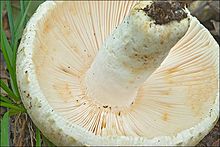| Russula virescens | |
|---|---|

| |

| |
| Scientific classification | |
| Domain: | Eukaryota |
| Kingdom: | Fungi |
| Division: | Basidiomycota |
| Class: | Agaricomycetes |
| Order: | Russulales |
| Family: | Russulaceae |
| Genus: | Russula |
| Species: | R. virescens
|
| Binomial name | |
| Russula virescens | |
| Synonyms[2] | |
| Russula virescens | |
|---|---|
| Gills on hymenium | |
| Cap is convex or flat | |
| Hymenium is adnate | |
| Stipe is bare | |
| Spore print is white to yellow | |
| Ecology is mycorrhizal | |
| Edibility is choice | |
Russula virescens is a basidiomycete mushroom of the genus Russula, and is commonly known as the green-cracking russula, the quilted green russula, or the green brittlegill. It can be recognized by its distinctive pale green cap that measures up to 15 cm (6 in) in diameter, the surface of which is covered with darker green angular patches. It has crowded white gills, and a firm, white stipe that is up to 8 cm (3 in) tall and 4 cm (1.6 in) thick. Considered to be one of the best edible mushrooms of the genus Russula, it is especially popular in Spain and China. With a taste that is described variously as mild, nutty, fruity, or sweet, it is cooked by grilling, frying, sautéeing, or eaten raw. Mushrooms are rich in carbohydrates and proteins, with a low fat content.
The species was described as new to science in 1774 by Jacob Christian Schaeffer. Its distribution encompasses Asia, North Africa, Europe, and Central America. Its presence in North America has not been clarified, due to confusion with the similar species Russula parvovirescens and R. crustosa. R. virescens fruits singly or scattered on the ground in both deciduous and mixed forests, forming mycorrhizal associations with broadleaf trees such as oak, European beech, and aspen. In Asia, it associates with several species of tropical lowland rainforest trees of the family Dipterocarpaceae. R. virescens has a ribonuclease enzyme with a biochemistry unique among edible mushrooms. It also has biologically active polysaccharides, and a laccase enzyme that can break down several dyes used in the laboratory and in the textile industry.